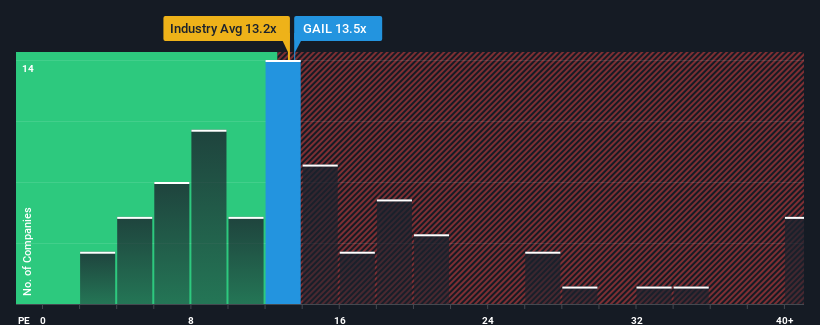- India
- /
- Gas Utilities
- /
- NSEI:GAIL
GAIL (India) Limited (NSE:GAIL) Looks Inexpensive But Perhaps Not Attractive Enough
When close to half the companies in India have price-to-earnings ratios (or "P/E's") above 33x, you may consider GAIL (India) Limited (NSE:GAIL) as a highly attractive investment with its 13.5x P/E ratio. Although, it's not wise to just take the P/E at face value as there may be an explanation why it's so limited.
Recent times have been advantageous for GAIL (India) as its earnings have been rising faster than most other companies. One possibility is that the P/E is low because investors think this strong earnings performance might be less impressive moving forward. If you like the company, you'd be hoping this isn't the case so that you could potentially pick up some stock while it's out of favour.
View our latest analysis for GAIL (India)

Does Growth Match The Low P/E?
The only time you'd be truly comfortable seeing a P/E as depressed as GAIL (India)'s is when the company's growth is on track to lag the market decidedly.
Retrospectively, the last year delivered an exceptional 172% gain to the company's bottom line. The latest three year period has also seen an excellent 52% overall rise in EPS, aided by its short-term performance. Therefore, it's fair to say the earnings growth recently has been superb for the company.
Shifting to the future, estimates from the analysts covering the company suggest earnings should grow by 0.6% each year over the next three years. That's shaping up to be materially lower than the 20% each year growth forecast for the broader market.
In light of this, it's understandable that GAIL (India)'s P/E sits below the majority of other companies. Apparently many shareholders weren't comfortable holding on while the company is potentially eyeing a less prosperous future.
The Key Takeaway
Typically, we'd caution against reading too much into price-to-earnings ratios when settling on investment decisions, though it can reveal plenty about what other market participants think about the company.
As we suspected, our examination of GAIL (India)'s analyst forecasts revealed that its inferior earnings outlook is contributing to its low P/E. At this stage investors feel the potential for an improvement in earnings isn't great enough to justify a higher P/E ratio. It's hard to see the share price rising strongly in the near future under these circumstances.
Having said that, be aware GAIL (India) is showing 1 warning sign in our investment analysis, you should know about.
You might be able to find a better investment than GAIL (India). If you want a selection of possible candidates, check out this free list of interesting companies that trade on a low P/E (but have proven they can grow earnings).
New: Manage All Your Stock Portfolios in One Place
We've created the ultimate portfolio companion for stock investors, and it's free.
• Connect an unlimited number of Portfolios and see your total in one currency
• Be alerted to new Warning Signs or Risks via email or mobile
• Track the Fair Value of your stocks
Have feedback on this article? Concerned about the content? Get in touch with us directly. Alternatively, email editorial-team (at) simplywallst.com.
This article by Simply Wall St is general in nature. We provide commentary based on historical data and analyst forecasts only using an unbiased methodology and our articles are not intended to be financial advice. It does not constitute a recommendation to buy or sell any stock, and does not take account of your objectives, or your financial situation. We aim to bring you long-term focused analysis driven by fundamental data. Note that our analysis may not factor in the latest price-sensitive company announcements or qualitative material. Simply Wall St has no position in any stocks mentioned.
About NSEI:GAIL
GAIL (India)
Operates as a natural gas processing and distribution company in India and internationally.
Established dividend payer and good value.
Similar Companies
Market Insights
Community Narratives



